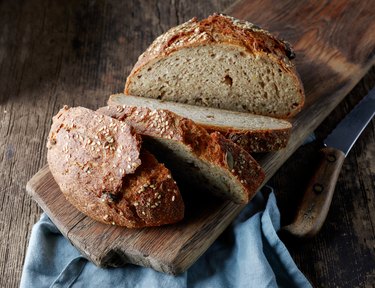
The beauty of bread is that it comes in different flavors, shapes and sizes. And sourdough is among the favorites.
While the tangy loaf is delicious, versatile and packs some health benefits, you'll want to be wary of food products you buy if you're on a gluten-free diet — especially when it comes to bread.
Video of the Day
Video of the Day
Is Sourdough Bread Gluten-Free?
Gluten is a protein found in wheat, rye and barley and these grains' derivatives. So, any food that contains these grains is a no-go for those with gluten sensitivity or celiac disease.
Most sourdough bread at the grocery store is produced with wheat flour, which means it contains gluten — unless the loaf is explicitly labeled gluten-free — according to Beyond Celiac.
Even though sourdough is fermented, it's still not necessarily safe to eat on a gluten-free diet.
Often a process used in the production of beer or wine, fermentation involves using a bacteria to break down the components of foods, including gluten-based grains, according to the USDA.
While fermenting some foods may break down gluten proteins enough for gluten-sensitive people to eat, that's not the case with sourdough bread, according to an April 2015 study published in Nutrients.
After observing and testing sourdough bread after fermentation, researchers found that the bread is not considered safe for people with celiac disease.
What's more, sourdough bread can be made in factories alongside other types of bread, posing a risk for cross-contact. Cross-contamination occurs when gluten foods come in contact with other ingredients either through manufacturing or preparation, according to the Celiac Disease Foundation.
When any foods are cross-contaminated, they can pose a risk for those with gluten intolerance or celiac.
How to Find a Gluten-Free Food Product
You can avoid the risk of cross-contact by choosing your food products carefully.
Generally, avoid buying gluten-free bread or pastries at a bakery, unless the location is certified gluten-free. Here's why: Employees sometimes re-use tongs or gloves, making it difficult to avoid cross-contamination.
At the grocery store, read the ingredient list of any food you decide to buy. Look out for any gluten-based foods and don't forget to check the allergen listing for wheat or gluten, too.
Then, look for a "Gluten-Free" label on the front package of the product. This label is regulated by the Food & Drug Administration (FDA) and signifies that the food you're eating has less than 20 parts per million (ppm) of gluten, which is generally safe for gluten-sensitive people and people with celiac disease to eat.
If you want even more security, buy foods that are labeled "Certified Gluten-Free" and are vetted by trusted third parties, like the Gluten-Free Certification Organization (GFCO).
The GFCO has especially strict standards, certifying foods that have only 10 ppm of gluten or less, according to the organization's website.
A Gluten-Free Sourdough Bread Recipe
If you're committed to making your own sourdough bread, there are plenty of gluten-free recipes you can try at home.
Next time you're craving a gluten-free avocado toast or grilled cheese, give this simple recipe a try.
Four-Ingredient Gluten-Free Sourdough Bread

This gluten-free sourdough bread recipe calls for only four simple ingredients, including GF flour, making it a pretty inexpensive and hassle-free baking project.
However, this recipe does need two days to produce, as you need to give the dough time to rise overnight.
Get the Four-Ingredient Gluten-Free Sourdough Bread recipe at What The Fork Food Blog.
- Beyond Celiac: "Is Sourdough Bread Gluten-Free?"
- USDA: "Evolution of Aroma Volatiles During Storage of sourdough Breads Made by Mixed Cultures of Kluyveromyces Marxianus and Lactobacillus Delbrueckii ssp. Bulgaricus or Lactobacillus Helveticus"
- USDA: "Safely Fermenting Food at Home"
- Nutrients: "Sourdough Fermentation of Wheat Flour does not Prevent the Interaction of Transglutaminase 2 With α2-Gliadin or Gluten"
- Clinical Gastroenterology and Hepatology: "Safety for Patients With Celiac Disease of Baked Goods Made of Wheat Flour Hydrolyzed During Food Processing"
- Celiac Disease Foundation: "Sources of Gluten"
- FDA: "Gluten and Food Labeling"
- GFCO: "About Us"